2007届高考考试说明解读(英语)[下学期]
文档属性
| 名称 | 2007届高考考试说明解读(英语)[下学期] |  | |
| 格式 | rar | ||
| 文件大小 | 152.1KB | ||
| 资源类型 | 教案 | ||
| 版本资源 | 通用版 | ||
| 科目 | 英语 | ||
| 更新时间 | 2007-05-05 22:13:00 | ||
图片预览

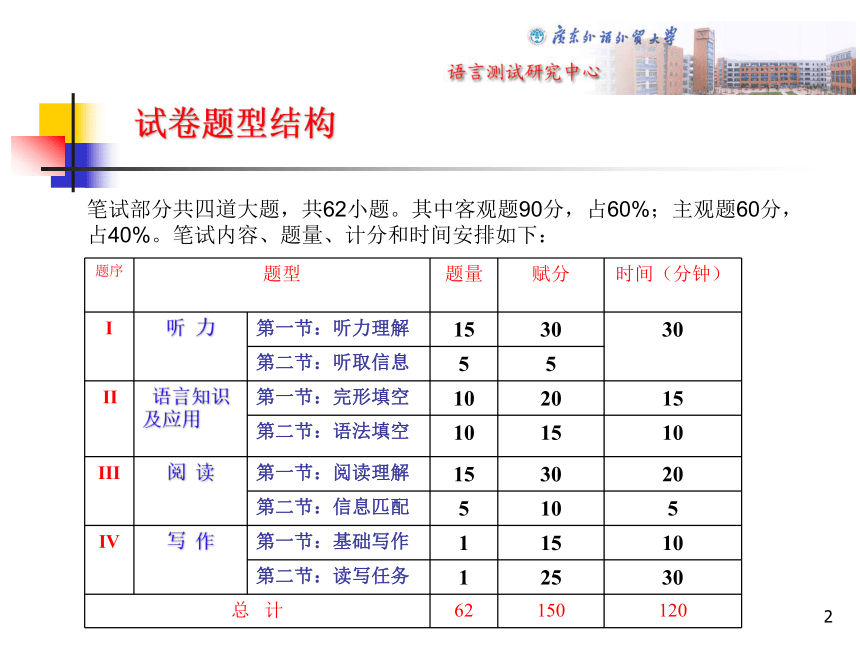
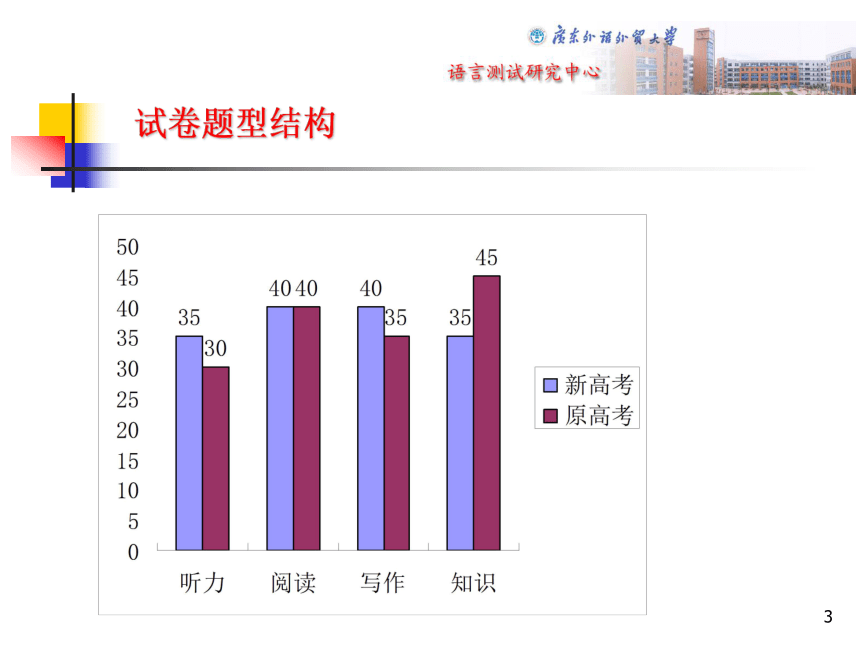
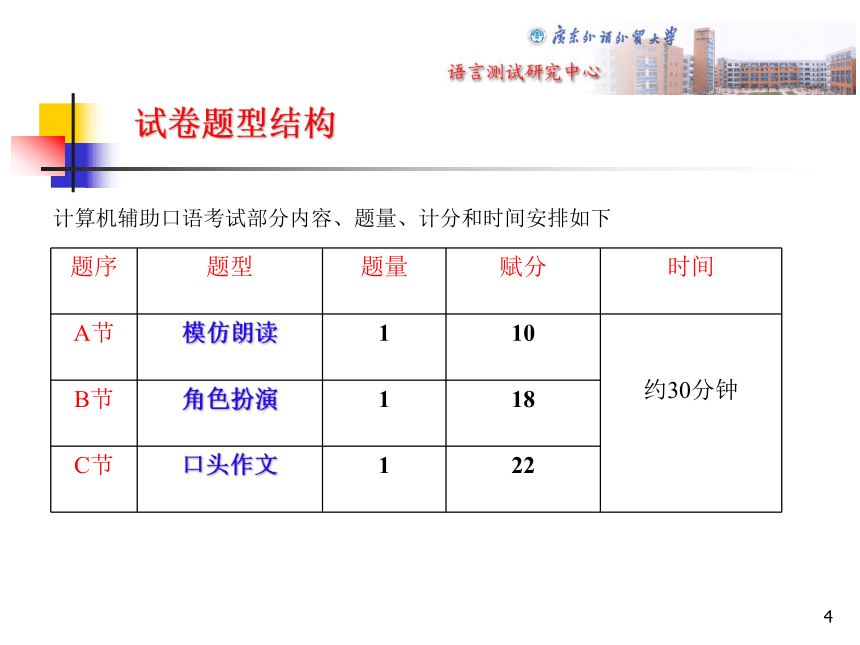
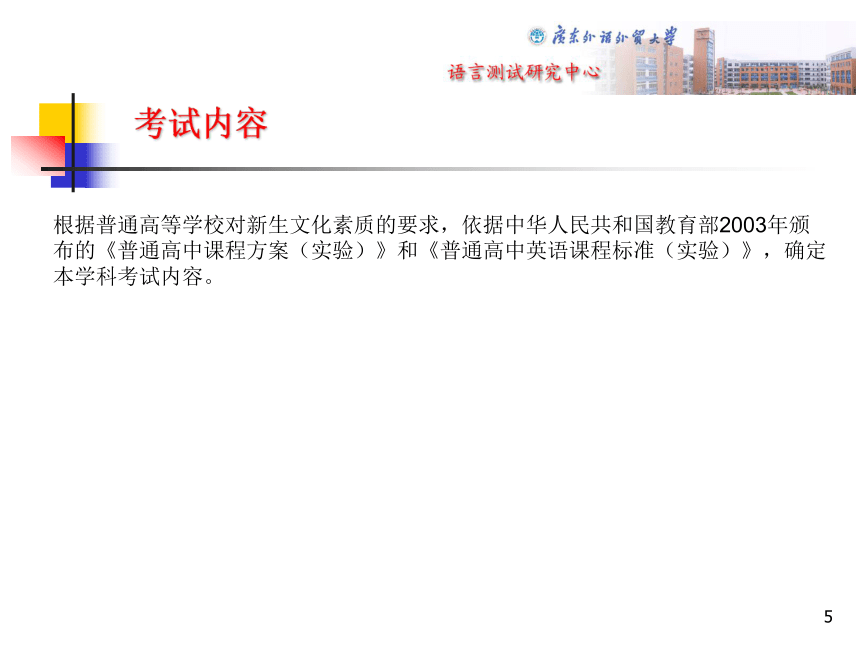
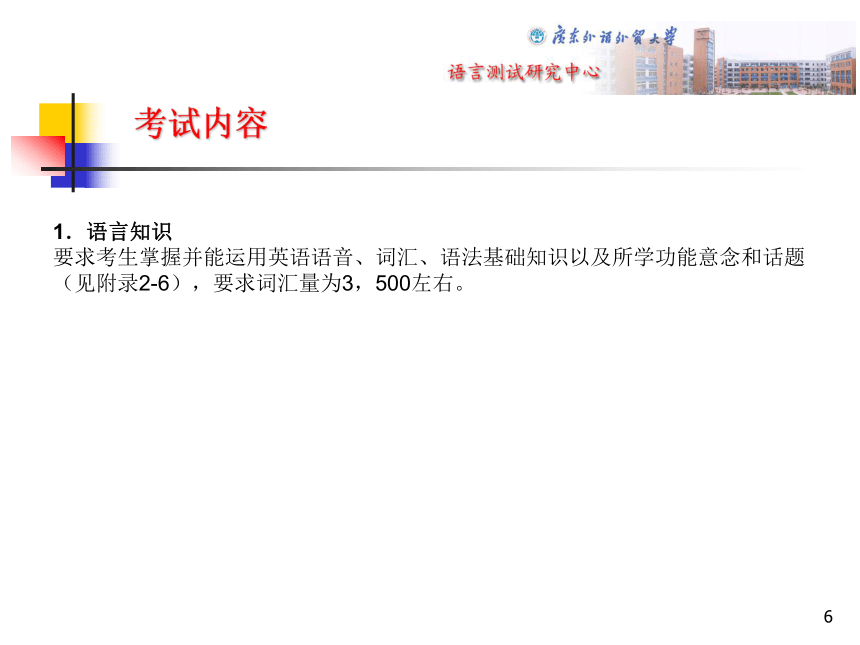

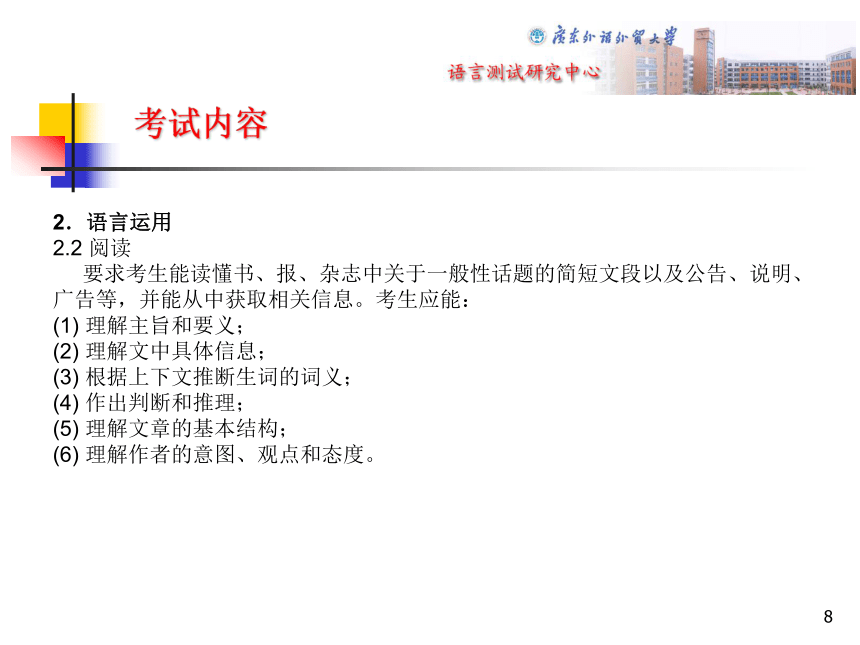
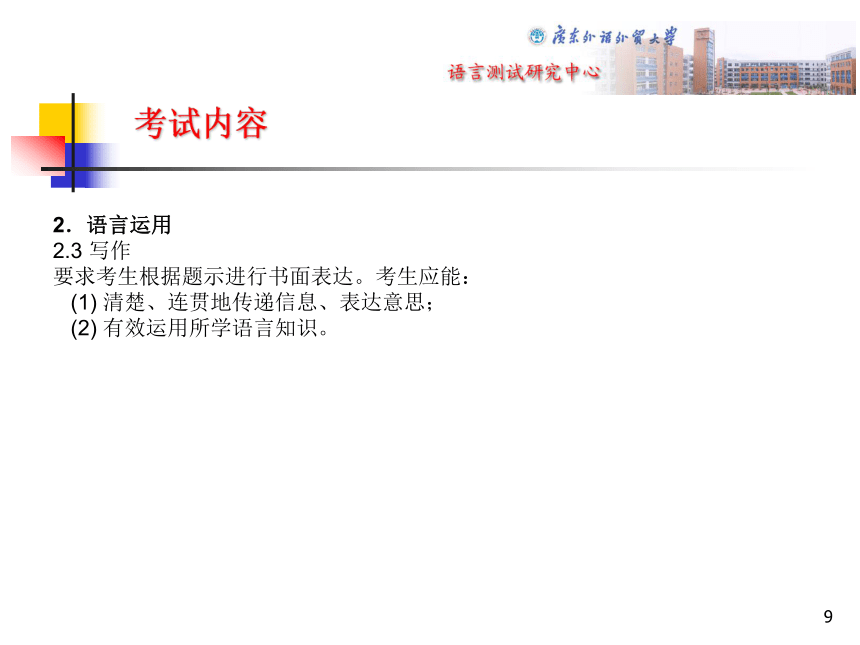
文档简介
课件28张PPT。浅谈07新高考
英语2试卷题型结构 笔试部分共四道大题,共62小题。其中客观题90分,占60%;主观题60分,占40%。笔试内容、题量、计分和时间安排如下: 3试卷题型结构 4计算机辅助口语考试部分内容、题量、计分和时间安排如下 试卷题型结构 5考试内容 根据普通高等学校对新生文化素质的要求,依据中华人民共和国教育部2003年颁布的《普通高中课程方案(实验)》和《普通高中英语课程标准(实验)》,确定本学科考试内容。61.语言知识
要求考生掌握并能运用英语语音、词汇、语法基础知识以及所学功能意念和话题(见附录2-6),要求词汇量为3,500左右。 考试内容 7考试内容 2.语言运用
2.1 听力
要求考生能听懂所熟悉话题的简短独白和对话。考生应能:
(1) 理解主旨和要义;
(2) 获取具体的、事实性信息;
(3) 对所听内容作出推断;
(4) 理解说话者的意图、观点和态度。 82.语言运用
2.2 阅读
要求考生能读懂书、报、杂志中关于一般性话题的简短文段以及公告、说明、广告等,并能从中获取相关信息。考生应能:
(1) 理解主旨和要义;
(2) 理解文中具体信息;
(3) 根据上下文推断生词的词义;
(4) 作出判断和推理;
(5) 理解文章的基本结构;
(6) 理解作者的意图、观点和态度。 考试内容 92.语言运用
2.3 写作
要求考生根据题示进行书面表达。考生应能:
(1) 清楚、连贯地传递信息、表达意思;
(2) 有效运用所学语言知识。 考试内容 102.语言运用
2.4 口语
要求考生根据题示进行口头表达。考生应能:
(1) 询问或传递事实性信息,表达意思和想法;
(2) 做到语音、语调自然;
(3) 做到语言运用得体;
(4) 使用有效的交际策略。考试内容 11题型示例 语法填空阅读下面短文,按照句子结构的语法性和上下文连贯的要求,在空格处填入适当的词或使用括号中词语的正确形式填空,并将答案填写在答题卡标号为31-40的相应位置上。
Thirty-two people watched Kitty Genovese 36 (kill) right below their windows. She was 37 neighbor. Yet 38 of the 32 helped her. Not one even called the police.
John Barley and Bib Fatane went beyond the headlines to research into the 39 why people didn’t act. They found that a person has to go through two steps 40 he can help. First he has to notice that it is 41 emergency. Is the smoke coming into the room 42 a leak in the air conditioning? Is it “steam pipes”? Or is it really smoke from a fire? It’s not always easy to tell if you are faced with a real emergency. Second, and 43 important, the person faced with an emergency must feel personally 44 (responsibility). He must feel that he must help, 45 the person won’t get the help he needs.12 “语法填空”要求考生阅读一篇短文,然后完成10项语法填空。内容包括根据句子的语法结构和上下文连贯的要求?填入适当的词语;或?使用括号中词语的适当形式填空。
“语法填空”考查考生在篇章层面上理解并应用语法知识的能力,考试采用填空的形式,而不是选择填空。“语法填空”要求考生必须具备较好的语法分析能力,而不只是语法辨析能力。 [题型说明]语法分析能力?题型示例 语法填空13语法分析以分析句子结构为主,分析的内容主要包括:
?句子的构成成分(包括句子的基本成分和扩展成分);
?句子成分之间的一致性,比如,主谓一致、时态一致等;
?句子的篇章制约;
?句子的意义制约。 [考点分析]题型示例 语法填空14语法填空← 结构分析语法意义:冠词、代词意义关系:代词、连词、介词上下文意义/搭配意义基本结构主谓一致时态一致指称一致主语一致扩展方式词性词形词义← 意义理解← 成分分析15返回16阅读下面短文,掌握其大意,然后从21~30各题所给的四个选项(A、B、C和D)中,选出最佳选项,并在答题卡上将该项涂黑。
This is not the world we know. The world is controlled by computers. Men and women can be seen, but they are following the __21___ given to them by machines. The __22___ were designed by mad scientists, but at some point even the mad scientists were taken over by their __23___.
Does this scenario sound familiar? You have probably read something like it in magazines or science-fiction books, or seen it in a sci-fi film. Why is the __24__ so popular? One of the ___25___ is undoubtedly that it reflects the fears of many people: fear of the unknown, fear of what is not understood or, ___26___, fear of something that is only partially __27___. This __28__ is perhaps not very different from the way witches and black cats were feared in the Middle Ages.
The ___29___ is that every day it seems that computers take control of another area of our__30___. Some factory jobs are now done by __31___ and the robots are controlled by computers. Our bank accounts are ___32___ by computers. At the airport, our tickets are issued and our seats are assigned by a computer. Certainly, many of these __33___ are made more efficient by computers, but our __34___ is sometimes combined with feelings of insecurity. And this __ 35__ is caused by the fact that we do not know how computers do these things, and we really don't know what they might do later.
21. A. orders B. rules C. programs D. words
22. A. programs B. machines C. robots D. ideas
23. A. super-powers B. super-inventions C. mad thoughts D. mad world
24. A. theme B. science C. scenario D. magazine
25. A. stories B. facts C. reasons D. doubts
26. A. at most B. at least C. at all D. above all
27. A. reflected B. recognized C. completed D. comprehended
28. A. idea B. fact C. fear D. reason
29. A. idea B. fact C. fear D. reason
30. A. lives B. world C. fears D. ages
31. A. hands B. computers C. people D. robots
32. A. done B. made C. managed D. controlled
33. A. operations B. jobs C. machines D. robots
34. A. curiosity B. admiration C. expectation D. amazement
35. A. thought B. idea C. combination D. insecurity 完形填空题型示例 17 “完形填空”要求考生阅读一篇短文,然后在空格处填入适当的词,内容涉及:
?词语在特定语境中的用法;
?篇章结构的衔接;
?篇章意义的连贯。
“完形填空”要求考生必须具备较强的篇章分析能力。 [题型说明]篇章分析能力?题型示例 完形填空18 篇章分析包括词、句和篇三个层面。在词的层面,主要包括词语搭配的合适性;在句的层面,主要涉及句子结构的语法性以及句子意义的逻辑性;在篇的层面,重点内容是?篇章结构的衔接手段以及?篇章意义的连贯。
归纳起来,“完形填空”的考点主要包括以下几个方面:
1.词语搭配
2.句子意义
3.篇章衔接
4.篇章连贯[考点分析]题型示例 完形填空19完形填空→意义分析→ 篇章衔接→ 篇章连贯固定搭配修饰结构主谓宾结构语法手段词汇手段过渡词语词句篇→ 词语搭配意义的逻辑性意义关系20基础写作[题型示例] 假设你去泰国旅游后,当地导游John请你在反馈表上写下对该旅行社提供的服务的意见或建议。
[写作内容]
1 .表示对旅行社提供的服务总体感到满意。
2 .当地导游对游客非常热情,体贴,耐心照顾团中的老人。
3.导游对游地讲解清晰、生动,增长了我们的见闻。
4.提出饭馆提供的膳食不合口味。
5.我们有些人不得不自买食物。
6.建议应该多提供货真价实的购物场所。
[写作要求]
必须使用5个句子介绍全部所给的内容;
将5个句子组织成连贯的短文。
[评分标准]
句子结构的准确性,信息内容的完整性和连贯性。论证报告题型示例 21[题型说明] 如何写出合乎英语语法的句子以及如何将句子连接成一篇连贯的作文是写作的基础。所以,基础写作要求考生掌握写作所需要的最基本技能:组词造句和连句成篇。题型示例 基础写作22[考点分析] 基础写作要求考生用5句表达所提供的全部信息点,这就要求考生具备以下几方面的能力:
信息整理:首先考生必须整理所提供的全部信息点,将它们分解成5个信息块。在内容方面,每个信息块必须包含同类信息,而且信息点之间存在逻辑关系;在结构方面,每个信息块必须能够用一个句子表达。
组词造句:用合乎语法的句子表达每个信息块的内容,句子结构首先保证它的正确性,其中最重要的是句子结构的完整性以及句子成分之间的一致性。
连句成篇:使用合适的方法将5个句子衔接成连贯的文段,常用的衔接手段包括代词指称、词汇重复或过渡词语。 题型示例 基础写作23 假设你去泰国旅游后,当地导游John请你在反馈表上写下对该旅行社提供的服务的意见或建议。
[写作内容]
1 .表示对旅行社提供的服务总体感到满意。
2 .当地导游对游客非常热情,体贴,耐心照顾团中的老人。
3.导游对游地讲解清晰、生动,增长了我们的见闻。
4.提出饭馆提供的膳食不合口味。
5.我们有些人不得不自买食物。
6.建议应该多提供货真价实的购物场所。I am quite satisfied with the travel agency. First of all, the local tour guide John was very enthusiastic and considerate to all tourists,especially to the older people. The local tour guide explained everything about the places we visited in a clear and lively way, which helped us broaden our horizons. However, the food provided in the restaurant didn’t agree with many of us and quite a few of us had to buy extra food. In addition, we wanted to be taken to the shops where we could buy good bargains but were not. 24基础写作信息整理语言表达篇章连贯信息归类信息关系基本结构句子扩展衔接手段篇章连贯完整性准确性连贯性25读写任务[题型示例]阅读下面的短文,然后按照要求写一篇150词左右的英语短文。
Let children learn to judge their own work. A child learning to talk does not learn by being corrected all the time; if corrected too much, he will stop talking. He notices a thousand times a day the difference between his language and others’ language. Bit by bit, he makes the right changes to make his language like other people’s. In the same way, children learn to do all the other things. They learn to talk, run, climb, ride a bicycle by comparing their own behaviors with those of more skilled people, and slowly make the needed changes. But in school teachers never give a child a chance to find out his mistakes for himself, even fewer chances for him to correct himself. They do it all for him. Teachers act as if the student would never notice a mistake if they did not point out it to him. They act as if the student would never correct it unless he was made to. Soon he becomes dependent on the teacher. Let the student do it himself. Let him work out, with the help of other children if he wants it, what this word means and what the answer is to that problem.
[写作内容]
1)以约30个词概括短文的要点;
2)然后以约120个词就“学生的学习错误该不该改正”的主题发表看法,并包括如下要点:
a) 你是如何看待自己的语言错误;
b) 老师是如何对待你的语言错误的;
c) 你对老师做法的看法及理由。
[写作要求]
可以使用实例或其它论述方法支持你的论点,也可以参照阅读材料的内容,但不得直接引用原文中的句子。
[评分标准]
概括准确、语言规范、内容合适,篇章连贯。题型示例 26[题型说明] “读写任务”要求考生阅读一篇短文,然后按照要求?概括相关主题的内容要点;并?就这个主题发表自己的看法或写一篇记事文等。“读写任务”属于有材料作文,考生必须通过阅读材料,概括要点并获取必要的信息,在此基础之上,写出自己的内容,比如:发表看法或编写故事等。这要求考生必须具备一定的阅读能力和较强的写作能力。题型示例 读写任务27 “读写任务”要求考生具备?阅读概括能力、?内容的组织能力、?语言表达能力以及?篇章的连贯组织能力等:
阅读概括能力:能够概括阅读材料的要点,并能够使用自己的语言组织梗概内容;
内容的组织能力:能够组织并整理用作写作内容的信息,包括如何利用阅读材料的信息、自己的亲身经历、观点和看法,以及其它来源的信息等;
语言表达能力:能够使用合乎语法规范的英语表达内容;
篇章的连贯组织能力:能够将内容组织成一篇连贯的英语短文。[考点分析]题型示例 读写任务28谢
谢
大
家 !
要求考生掌握并能运用英语语音、词汇、语法基础知识以及所学功能意念和话题(见附录2-6),要求词汇量为3,500左右。 考试内容 7考试内容 2.语言运用
2.1 听力
要求考生能听懂所熟悉话题的简短独白和对话。考生应能:
(1) 理解主旨和要义;
(2) 获取具体的、事实性信息;
(3) 对所听内容作出推断;
(4) 理解说话者的意图、观点和态度。 82.语言运用
2.2 阅读
要求考生能读懂书、报、杂志中关于一般性话题的简短文段以及公告、说明、广告等,并能从中获取相关信息。考生应能:
(1) 理解主旨和要义;
(2) 理解文中具体信息;
(3) 根据上下文推断生词的词义;
(4) 作出判断和推理;
(5) 理解文章的基本结构;
(6) 理解作者的意图、观点和态度。 考试内容 92.语言运用
2.3 写作
要求考生根据题示进行书面表达。考生应能:
(1) 清楚、连贯地传递信息、表达意思;
(2) 有效运用所学语言知识。 考试内容 102.语言运用
2.4 口语
要求考生根据题示进行口头表达。考生应能:
(1) 询问或传递事实性信息,表达意思和想法;
(2) 做到语音、语调自然;
(3) 做到语言运用得体;
(4) 使用有效的交际策略。考试内容 11题型示例 语法填空阅读下面短文,按照句子结构的语法性和上下文连贯的要求,在空格处填入适当的词或使用括号中词语的正确形式填空,并将答案填写在答题卡标号为31-40的相应位置上。
Thirty-two people watched Kitty Genovese 36 (kill) right below their windows. She was 37 neighbor. Yet 38 of the 32 helped her. Not one even called the police.
John Barley and Bib Fatane went beyond the headlines to research into the 39 why people didn’t act. They found that a person has to go through two steps 40 he can help. First he has to notice that it is 41 emergency. Is the smoke coming into the room 42 a leak in the air conditioning? Is it “steam pipes”? Or is it really smoke from a fire? It’s not always easy to tell if you are faced with a real emergency. Second, and 43 important, the person faced with an emergency must feel personally 44 (responsibility). He must feel that he must help, 45 the person won’t get the help he needs.12 “语法填空”要求考生阅读一篇短文,然后完成10项语法填空。内容包括根据句子的语法结构和上下文连贯的要求?填入适当的词语;或?使用括号中词语的适当形式填空。
“语法填空”考查考生在篇章层面上理解并应用语法知识的能力,考试采用填空的形式,而不是选择填空。“语法填空”要求考生必须具备较好的语法分析能力,而不只是语法辨析能力。 [题型说明]语法分析能力?题型示例 语法填空13语法分析以分析句子结构为主,分析的内容主要包括:
?句子的构成成分(包括句子的基本成分和扩展成分);
?句子成分之间的一致性,比如,主谓一致、时态一致等;
?句子的篇章制约;
?句子的意义制约。 [考点分析]题型示例 语法填空14语法填空← 结构分析语法意义:冠词、代词意义关系:代词、连词、介词上下文意义/搭配意义基本结构主谓一致时态一致指称一致主语一致扩展方式词性词形词义← 意义理解← 成分分析15返回16阅读下面短文,掌握其大意,然后从21~30各题所给的四个选项(A、B、C和D)中,选出最佳选项,并在答题卡上将该项涂黑。
This is not the world we know. The world is controlled by computers. Men and women can be seen, but they are following the __21___ given to them by machines. The __22___ were designed by mad scientists, but at some point even the mad scientists were taken over by their __23___.
Does this scenario sound familiar? You have probably read something like it in magazines or science-fiction books, or seen it in a sci-fi film. Why is the __24__ so popular? One of the ___25___ is undoubtedly that it reflects the fears of many people: fear of the unknown, fear of what is not understood or, ___26___, fear of something that is only partially __27___. This __28__ is perhaps not very different from the way witches and black cats were feared in the Middle Ages.
The ___29___ is that every day it seems that computers take control of another area of our__30___. Some factory jobs are now done by __31___ and the robots are controlled by computers. Our bank accounts are ___32___ by computers. At the airport, our tickets are issued and our seats are assigned by a computer. Certainly, many of these __33___ are made more efficient by computers, but our __34___ is sometimes combined with feelings of insecurity. And this __ 35__ is caused by the fact that we do not know how computers do these things, and we really don't know what they might do later.
21. A. orders B. rules C. programs D. words
22. A. programs B. machines C. robots D. ideas
23. A. super-powers B. super-inventions C. mad thoughts D. mad world
24. A. theme B. science C. scenario D. magazine
25. A. stories B. facts C. reasons D. doubts
26. A. at most B. at least C. at all D. above all
27. A. reflected B. recognized C. completed D. comprehended
28. A. idea B. fact C. fear D. reason
29. A. idea B. fact C. fear D. reason
30. A. lives B. world C. fears D. ages
31. A. hands B. computers C. people D. robots
32. A. done B. made C. managed D. controlled
33. A. operations B. jobs C. machines D. robots
34. A. curiosity B. admiration C. expectation D. amazement
35. A. thought B. idea C. combination D. insecurity 完形填空题型示例 17 “完形填空”要求考生阅读一篇短文,然后在空格处填入适当的词,内容涉及:
?词语在特定语境中的用法;
?篇章结构的衔接;
?篇章意义的连贯。
“完形填空”要求考生必须具备较强的篇章分析能力。 [题型说明]篇章分析能力?题型示例 完形填空18 篇章分析包括词、句和篇三个层面。在词的层面,主要包括词语搭配的合适性;在句的层面,主要涉及句子结构的语法性以及句子意义的逻辑性;在篇的层面,重点内容是?篇章结构的衔接手段以及?篇章意义的连贯。
归纳起来,“完形填空”的考点主要包括以下几个方面:
1.词语搭配
2.句子意义
3.篇章衔接
4.篇章连贯[考点分析]题型示例 完形填空19完形填空→意义分析→ 篇章衔接→ 篇章连贯固定搭配修饰结构主谓宾结构语法手段词汇手段过渡词语词句篇→ 词语搭配意义的逻辑性意义关系20基础写作[题型示例] 假设你去泰国旅游后,当地导游John请你在反馈表上写下对该旅行社提供的服务的意见或建议。
[写作内容]
1 .表示对旅行社提供的服务总体感到满意。
2 .当地导游对游客非常热情,体贴,耐心照顾团中的老人。
3.导游对游地讲解清晰、生动,增长了我们的见闻。
4.提出饭馆提供的膳食不合口味。
5.我们有些人不得不自买食物。
6.建议应该多提供货真价实的购物场所。
[写作要求]
必须使用5个句子介绍全部所给的内容;
将5个句子组织成连贯的短文。
[评分标准]
句子结构的准确性,信息内容的完整性和连贯性。论证报告题型示例 21[题型说明] 如何写出合乎英语语法的句子以及如何将句子连接成一篇连贯的作文是写作的基础。所以,基础写作要求考生掌握写作所需要的最基本技能:组词造句和连句成篇。题型示例 基础写作22[考点分析] 基础写作要求考生用5句表达所提供的全部信息点,这就要求考生具备以下几方面的能力:
信息整理:首先考生必须整理所提供的全部信息点,将它们分解成5个信息块。在内容方面,每个信息块必须包含同类信息,而且信息点之间存在逻辑关系;在结构方面,每个信息块必须能够用一个句子表达。
组词造句:用合乎语法的句子表达每个信息块的内容,句子结构首先保证它的正确性,其中最重要的是句子结构的完整性以及句子成分之间的一致性。
连句成篇:使用合适的方法将5个句子衔接成连贯的文段,常用的衔接手段包括代词指称、词汇重复或过渡词语。 题型示例 基础写作23 假设你去泰国旅游后,当地导游John请你在反馈表上写下对该旅行社提供的服务的意见或建议。
[写作内容]
1 .表示对旅行社提供的服务总体感到满意。
2 .当地导游对游客非常热情,体贴,耐心照顾团中的老人。
3.导游对游地讲解清晰、生动,增长了我们的见闻。
4.提出饭馆提供的膳食不合口味。
5.我们有些人不得不自买食物。
6.建议应该多提供货真价实的购物场所。I am quite satisfied with the travel agency. First of all, the local tour guide John was very enthusiastic and considerate to all tourists,especially to the older people. The local tour guide explained everything about the places we visited in a clear and lively way, which helped us broaden our horizons. However, the food provided in the restaurant didn’t agree with many of us and quite a few of us had to buy extra food. In addition, we wanted to be taken to the shops where we could buy good bargains but were not. 24基础写作信息整理语言表达篇章连贯信息归类信息关系基本结构句子扩展衔接手段篇章连贯完整性准确性连贯性25读写任务[题型示例]阅读下面的短文,然后按照要求写一篇150词左右的英语短文。
Let children learn to judge their own work. A child learning to talk does not learn by being corrected all the time; if corrected too much, he will stop talking. He notices a thousand times a day the difference between his language and others’ language. Bit by bit, he makes the right changes to make his language like other people’s. In the same way, children learn to do all the other things. They learn to talk, run, climb, ride a bicycle by comparing their own behaviors with those of more skilled people, and slowly make the needed changes. But in school teachers never give a child a chance to find out his mistakes for himself, even fewer chances for him to correct himself. They do it all for him. Teachers act as if the student would never notice a mistake if they did not point out it to him. They act as if the student would never correct it unless he was made to. Soon he becomes dependent on the teacher. Let the student do it himself. Let him work out, with the help of other children if he wants it, what this word means and what the answer is to that problem.
[写作内容]
1)以约30个词概括短文的要点;
2)然后以约120个词就“学生的学习错误该不该改正”的主题发表看法,并包括如下要点:
a) 你是如何看待自己的语言错误;
b) 老师是如何对待你的语言错误的;
c) 你对老师做法的看法及理由。
[写作要求]
可以使用实例或其它论述方法支持你的论点,也可以参照阅读材料的内容,但不得直接引用原文中的句子。
[评分标准]
概括准确、语言规范、内容合适,篇章连贯。题型示例 26[题型说明] “读写任务”要求考生阅读一篇短文,然后按照要求?概括相关主题的内容要点;并?就这个主题发表自己的看法或写一篇记事文等。“读写任务”属于有材料作文,考生必须通过阅读材料,概括要点并获取必要的信息,在此基础之上,写出自己的内容,比如:发表看法或编写故事等。这要求考生必须具备一定的阅读能力和较强的写作能力。题型示例 读写任务27 “读写任务”要求考生具备?阅读概括能力、?内容的组织能力、?语言表达能力以及?篇章的连贯组织能力等:
阅读概括能力:能够概括阅读材料的要点,并能够使用自己的语言组织梗概内容;
内容的组织能力:能够组织并整理用作写作内容的信息,包括如何利用阅读材料的信息、自己的亲身经历、观点和看法,以及其它来源的信息等;
语言表达能力:能够使用合乎语法规范的英语表达内容;
篇章的连贯组织能力:能够将内容组织成一篇连贯的英语短文。[考点分析]题型示例 读写任务28谢
谢
大
家 !
